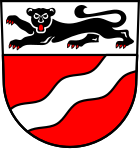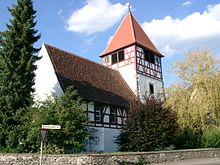Weissbach (Hohenlohe)
| coat of arms | Germany map | |
|---|---|---|

|
Coordinates: 49 ° 18 ' N , 9 ° 36' E |
|
| Basic data | ||
| State : | Baden-Württemberg | |
| Administrative region : | Stuttgart | |
| County : | Hohenlohe district | |
| Local government association: | " Middle Kocher Valley " | |
| Height : | 201 m above sea level NHN | |
| Area : | 12.77 km 2 | |
| Residents: | 2021 (December 31, 2018) | |
| Population density : | 158 inhabitants per km 2 | |
| Postal code : | 74679 | |
| Area code : | 07947 | |
| License plate : | KÜN, EAR | |
| Community key : | 08 1 26 086 | |
| Community structure: | 2 districts | |
| Address of the municipal administration: |
Niedernhaller Strasse 5 74679 Weißbach |
|
| Website : | ||
| Mayor : | Rainer Zuefle | |
| Location of the community of Weißbach in the Hohenlohe district | ||
Weißbach is a municipality in Kochertal in the Hohenlohekreis in the Franconian north-east of Baden-Württemberg . It belongs to the Heilbronn-Franconia region (until May 20, 2003 Franconia region ).
geography
location
Weißbach is located in the middle Kochertal at the confluence of the Langenbach in the Kocher between 200 and 430 m above sea level. NN Höhe, 10 km west of the district town of Künzelsau . The community consists of the formerly independent localities Weißbach with the hamlet Guthof and Crispenhofen with the hamlet Halberg.
Community structure
The former municipality of Crispenhofen belongs to Weißbach . The village of Crispenhofen and the hamlet of Halberg as well as the abandoned villages of Breitental, Entberg, Wallenstein and Hettenbach belong to the former municipality of Crispenhofen. The village of Weißbach, the hamlet Guthof and the Schlössle house belong to the municipality of Weißbach within the borders of December 31, 1973 .
Division of space

According to data from the State Statistical Office , as of 2014.
history
Until the 19th century
Weißbach is first mentioned in a document in 1283. Weißbach, old Wysbach, named after the white foaming brook, was originally part of the Forchtenberg-Wulfingen estate.
Salt production begins at the end of the Middle Ages . In the neighboring community of Niedernhall , brine was pumped, which then flowed through wooden pipes to two salt pans in Weißbach, where the salt was obtained by heating . In the 18th century, however, salt production became unprofitable because the salt content of the brine had decreased. One of the salt pans then became a mill. After it burned down at the end of the 19th century, a textile factory was founded on the same site. After Konrad Hornschuch joined the company as a partner around 1920, it became a plastics factory and was at times the largest employer in the Hohenlohe district. The other saltworks is commonly known as Schlössle and housed an agricultural business for a long time after the saltworks was closed.
20th century
In the mid-1920s, the railway ( Kochertalbahn ) also reached Weißbach. However, passenger traffic was replaced by regular buses in 1980 and freight traffic was shut down in 1990. The tracks have now been dismantled and the route is used as a cycle path in many places (such as between Weißbach and Forchtenberg ).
The Evangelical Church of Weißbach has been a listed building since 1929, as fragments of medieval frescoes were discovered and exposed during a restoration in 1923. The paintings began to crumble off the damp walls in the 1930s. In 1937 a wall had to be completely torn down during another renovation, which meant that some of the paintings could not be saved. During a further repair in 1957, paintings were discovered again that were successfully restored. All paintings were probably made shortly before 1400 and showed or show scenes from the Passion Path of Jesus. Until the cooker was straightened out, the church was sometimes flooded during floods.
Legend
The residents of Weißbach have the local name Krappenstecher . This goes back to the legend that the Weißbachers were so poor that they stabbed Krappen ( ravens in Hohenlohisch ) to eat them. Young ravens are supposed to taste like pigeons. In memory of this legend, the street festival in Weißbach is called the Krappenstecherfest every two years .
Districts
Crispenhofen
Crispenhofen was originally called Criesbachhofen, so named because it was a farm near Criesbach or, according to other sources, the farm of a gentleman from Criegesbach . Crispenhofen is first mentioned in a document in 1344. In earlier centuries this was also the larger town of today's Weissbach municipality. However, this has changed rapidly and sustainably since industrialization. Above Crispenhofen lies the hamlet of Halberg, which consists of several houses and which belonged to Crispenhofen until it was incorporated.
Religions
The majority of the residents are Protestant. After the Second World War, Catholics also moved to Weißbach. In addition to the two Protestant churches in Weißbach and Crispenhofen, there is now a Catholic, a New Apostolic church in Weißbach and a Baptist church in Crispenhofen.
Incorporations
- January 1, 1974: Crispenhofen
politics
Municipal council
In Weißbach, the municipal council is elected using the false sub-district election. The number of local councils can change due to overhang mandates . The municipal council in Weißbach has 12 members after the last election. The local elections on May 25, 2014 led to the following official final result. The turnout was 47.0% (2009: 50.3%). The municipal council consists of the elected voluntary councilors and the mayor as chairman. The mayor is entitled to vote in the municipal council.
| Free electoral association | 43.25% | 5 seats |
| Civic voters' association | 42.21% | 5 seats |
| SPD | 14.54% | 2 seats |
mayor
Rainer Züfle was elected to succeed Manfred Görke in 1997 and was confirmed in office in 2005 and 2013.
badges and flags
The blazon of the Weißbach coat of arms reads: Under a silver shield head, inside a striding, red armored and red-tongued, looking black lion (leopard), in red a silver wave oblique left bar. The flag of the municipality is white and red.
A Weißbach seal from 1831 showed three trees. In 1958, with the advice of the Stuttgart Archives Directorate, Weissbach established a coat of arms in which the wavy bar refers to the community name ( -bach ), while the leopard comes from the Hohenlohe coat of arms and represents Weissbach's affiliation to Hohenlohe since 1323. The flag colors are the Hohenlohe house colors. The coat of arms and flag were awarded to the community on January 19, 1959 by the Baden-Württemberg Ministry of the Interior.
Economy and Infrastructure
traffic
Weißbach is located on the Kocher-Jagst-Radweg and on the Württemberg Wine Route of the former Swabian Wine Route . Up until the beginning of the 20th century, the economy was dominated by agriculture, but agriculture and viticulture have only played a very subordinate role since the strong industrialization of the Kochertal valley.
The main traffic axis is the Kochertalstraße L 1045. From here the L 1046 branches off in the local area, which leads through the Langenbachtal to Crispenhofen and on to the Schöntal district of Westernhausen in the Jagsttal . The K 2318 connects Crispenhofen with the Ingelfingen district of Criesbach. The two hamlets Guthof and Halberg can be reached via low-level roads.
Established businesses
The Konrad Hornschuch AG (manufacturer of dc-fix films and skai leatherette) has its headquarters in Weissbach. The company's location goes back to the textile factory Schaufler & Wundt, which was opened in 1891 on the site of a burnt down grinding mill, which was converted into a GmbH in 1898, later developed into a manufacturer of calico and artificial leather and was merged with Konrad Hornschuch AG, originally located in Urbach, in 1927 . After a major fire almost completely destroyed the plant in Weißbach in 1968, a new production facility was built there, which finally became the company's headquarters in 1976.
education
Weißbach has its own primary school as well as two Protestant kindergartens (Weißbach and Crispenhofen) and a library.
Sports
Weißbach has a gym and a sports and hard court. There is a tennis facility in Crispenhofen.
literature
- Jürgen Hermann Rauser: Weissbacher Heimatbuch . Weißbach community, Weißbach 1982 (Hohenlohekreis local library, 10).
- Weissbach . In: Description of the Oberamt Künzelsau . 1883 ( Wikisource )
- Crispenhofen . In: Description of the Oberamt Künzelsau . 1883 ( Wikisource )
Web links
Individual evidence
- ↑ State Statistical Office Baden-Württemberg - Population by nationality and gender on December 31, 2018 (CSV file) ( help on this ).
- ^ The state of Baden-Württemberg. Official description by district and municipality. Volume IV: Stuttgart district, Franconian and East Württemberg regional associations. Kohlhammer, Stuttgart 1980, ISBN 3-17-005708-1 , pp. 227-228.
- ↑ State Statistical Office, area since 1988 according to actual use for Weißbach.
- ↑ a b c d Rauser (see literature)
- ^ Federal Statistical Office (ed.): Historical municipality directory for the Federal Republic of Germany. Name, border and key number changes in municipalities, counties and administrative districts from May 27, 1970 to December 31, 1982 . W. Kohlhammer, Stuttgart / Mainz 1983, ISBN 3-17-003263-1 , p. 466 .
- ↑ Stimme.de
- ↑ Heinz Bardua: The district and community coats of arms in the Stuttgart administrative region . Theiss, Stuttgart 1987, ISBN 3-8062-0801-8 (district and municipality coat of arms in Baden-Württemberg, 1), p. 140.
- ↑ feuerwehr-weissbach.de




